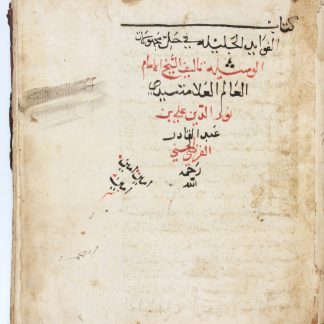[VERKAUFT]
Dieses Stück ist bereits verkauft. Am Ankauf eines gleichwertigen Exemplars bzw. von Stücken ähnlicher Bedeutung sind wir immer interessiert.
Euclid's "Elements" in Arabic
Kitab Uqlidis fi ilm al-handasa [An exposition on mathematics and geometry taken from Euclid's Elements].
8vo (195 x 110 mm). Decorated Arabic manuscript on paper. 162 leaves, apparently complete, single column, 20 lines black nasta'liq influenced by naskh, overlining and some phrases in red, numerous diagrams and tables throughout the text ruled in black and red, catch-words throughout, text-block ruled in red and gold, occasional marginal commentary in red and black. Contemporary red morocco boards with flap, ruled in gilt.
A charming Arabic manuscript of Euclid's "Elements". The Persian scholar Muhamad ibn Muhamad ibn al-Hasan al-Tusi (1201-74) was known for his extensive work on science, physics, mathematics and theology; he is often credited with the invention and identification of trigonometry as an independent division of mathematics. As well as compiling many important works in these fields, he is also known for translating the definitive Arabic editions of Euclid, Ptolemy and Archimedes' works, among others.
The present text is a translation of Euclid's "Elements", focusing on the discussion of mathematical and geometric area, and is illustrated throughout with many detailed diagrams and charts. The earliest known copy of this work dates to the 13th century; however, few examples have appeared on the market in recent decades, and it is considered a uncommon work in manuscript. The last example to appear is the Persian copy dated 1061 AH (AD 1650), sold at Bonhams, 6 October 2008, lot 15, for £9,600, and perhaps we should add to this the abridgement of the work from Ilkhanid Persia and dated 701 AH (AD 1301/02), sold at Sotheby's, 26 April 2017, lot 38, for £12,500.
Binding rebacked and creases repaired, rather scuffed. A few outer edges repaired, some light scuffs and small smudges to some sections of text, a few small chips and closed tears to outer edges, rarely affecting text.
Cf. GAL I, 510, 23 & S I, 929.









